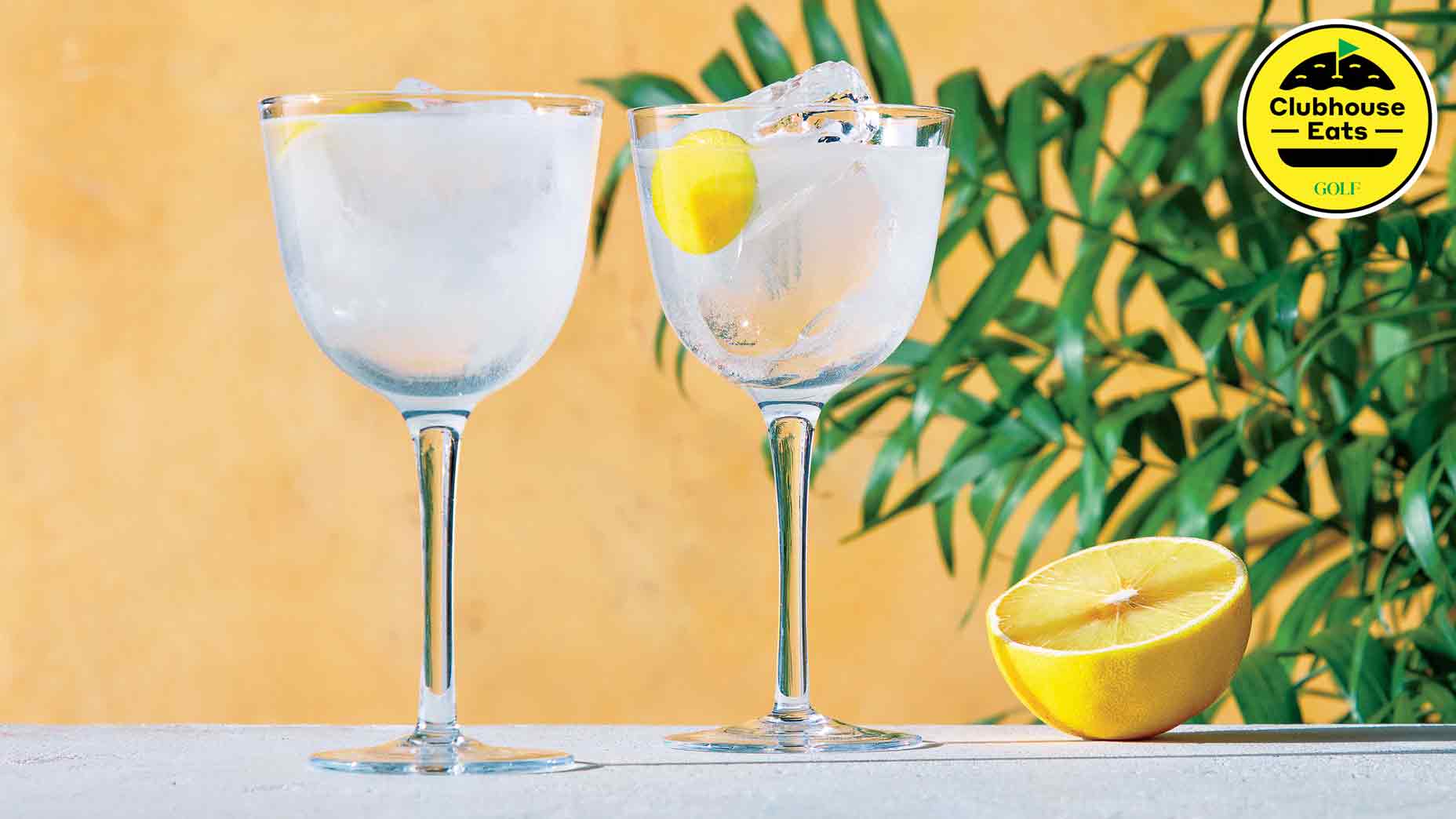Welcome to Clubhouse Eats, where we celebrate the game’s most delectable food and drink. Hope you brought your appetite.
***
If you play golf and you’re of legal drinking age, chances are you’ve enjoyed the occasional Transfusion out on the course. A mixture of grape juice, ginger ale and vodka, the beverage was popular with President Dwight D. Eisenhower — an avid golfer, himself — so we know it’s been around at least since the mid-1950s.
We also know — or can confidently assume, anyway — that the drink was concocted as a “hair of the dog” hangover remedy, thus its clever name. After all, the vodka is likely to soften a headache (at least temporarily), the grape juice is a source of much-needed electrolytes, and the ginger ale can aid in settling an upset stomach.
That’s all we really know about the cocktail’s history; however, there’s plenty to talk about in regards to the drink today. Most notably, more and more golf clubs are putting their own spin on the classic recipe, creating beverages that riff on nostalgia, while delivering refreshment in contemporary ways. Here, we share advice from several beverage directors (including some of their recipes), giving you a championship-worthy playbook for concocting unique Transfusions of your own.
A taste of childhood
“The possibilities are endless,” says Wendy Wilroy, the director of food and beverage at Deerfield Golf Club in Delaware. “Don’t be afraid to switch up the juice — pomegranate, blueberry, blackberry, cranberry or white grape juice all make great alternatives. And any variation that includes a fizzy mixer like ginger beer, tonic water or lemon-lime soda that’s paired with grape or a similar juice and a base spirit can still be considered a riff on the Transfusion. There’s plenty of room to play while still honoring the original.”
To prove just how much room there is, Wilroy has concocted a PB&J Transfusion that relies on Screwball Whiskey in place of vodka. (To make it, in a pint glass, combine two ounces of Screwball with two ounces of grape juice, fill with ice and then top with ginger ale.) Pairing it with an Uncrustable, she says, creates “the ultimate grown-up throwback.”
Kicking it up a notch
At Canyon Creek Country Club in Texas, master mixologist Ben Chavez serves up nostalgia with his own twist on a Transfusion — one that substitutes grape juice for a pomegranate-enhanced syrup and is served in a re-sealable pouch. “It’s like a spiked Capri Sun!” he says of his creation, The Pomfusion.

Wyndham Clark helps social-media star Chance Cozby make the perfect post-round cocktail
By:
Jessica Marksbury
As Chavez acknowledges, the drink’s recipe — a mixture of 1.5 ounces of vodka, one ounce of a pomegranate-infused tincture syrup, half an ounce of lime juice, three dashes of Scappy’s Firewater bitters, and a top off of ginger beer — is still an homage to the classic, but it’s packed with powerful antioxidants and nutrients. “It’s super refreshing, easy on the palate,” he says, “and it’s got a kick.”
Fortune favors the bold
Danielle O’Neal, a bartender at Sea Pines Resort’s flagship restaurant, Links, an American Grill, reiterates the notion that twists on a Transfusion can be bold. While she encourages at-home bartenders to play around with the combination of spirits and fruit juices, she says it’s imperative to “keep the essence of the cocktail — refreshing, hydrating and strong.” The restaurant’s Guadalajara Transfusion (recipe below) is a perfect example.
Guadalajara Transfusion
1.5 oz. Lalo tequila
0.5 oz. homemade lime cordial
0.25 oz. Giffard Ginger Alcohol Free
2 oz. ginger ale
1 oz. Welch’s grape juice
Less can be ore
Robert Izen, the director of food and beverage at Gamble Sands, takes a more conservative approach when riffing on a Transfusion. In his opinion, a drink can only be called a Transfusion if it features a fruit juice; a carbonated, ginger-flavored beverage; and a clear spirit.
At Gamble Sands, he makes a Huckleberry Transfusion by mixing three-quarters of an ounce of huckleberry-flavored vodka with three-quarters of an ounce of regular vodka, then adds grape juice, ginger beer and splashes of Sprite and ruby red grapefruit juice. (Don’t forget to garnish with a lime wedge.)
When experimenting, he makes sure to focus on juices that are both sweet and tart, and he says that combining a homemade ginger syrup with soda water can offer more control over the sweetness and spice. As for the base spirit, he likes light rum for a tropical twist and tequila for its zesty character, while gin can give a drink more botanical notes. “Small substitutions,” he says, “can lead to big flavor changes.”
Frozen assets
Not all spin-offs require ingredient substitutions. That’s the lesson to be learned at any of the Dormie Network’s private golf clubs, where classic Transfusions are served up as adults-only slushies. They’re also easily made at home, provided you invest in a Ninja Slushi Frozen Drink Maker. Once armed with the necessary appliance, simply mix up a large batch of a classic Transfusion, pour it into the Slushi machine, make sure the mode is set to “Spiked Slush” and turn it on. (Insider tip: Keep an eye on the contents as the machine does its thing — the presence of alcohol will slow the concoction’s freezing rate.)
As the folks at The Dormie Club have shared, once the frozen Transfusion is ready, just pour it into a chilled glass and garnish with a wheel or wedge of lime.
Creative lessons
As you’ve learned by now, there’s no shortage of ways to playfully riff on a Transfusion. If you’re up for true experimentation on your own, Kristin Kelly, an operations specialist at Chasing Aces in Louisiana, offers some sage advice. “It’s not just about the ingredients, it’s about the perfect combination of them,” she says. “Refreshing fruit flavor, the gentle spice of ginger, bubbly fizz and a tall glass filled with ice — together, these create the easygoing, satisfying character that makes a Transfusion recognizable.”

At the Rosewood Mayakoba, the signature cocktail is one of a kind
By:
Jessica Marksbury
Kelly explains that grape juice works so well in the original cocktail because it’s sweet and easy to drink; however, she acknowledges that you can find that same character in other fruit juices. “Blueberry or pomegranate are natural choices,” she says, “while plum, elderberry or even watermelon can offer a fresh take that still feels true to the original.”
The drink’s other defining flavor is ginger — usually incorporated through the use of ginger ale — but Kelly suggests focusing on the root (ha!) of that flavor. “Think about that as simply ginger,” she advises, “and you open the door to ginger beer for more spice, ginger syrups for depth or fresh ginger for brightness, whichever pairs best with your chosen fruit.”
From there, you can add even more unique twists based on the flavors that might be popular for a particular time of year. Says Kelly: “Once you have your berry and ginger foundation, spices and herbs can bring in seasonality without losing the essence of a Transfusion.”



Dining and Cooking